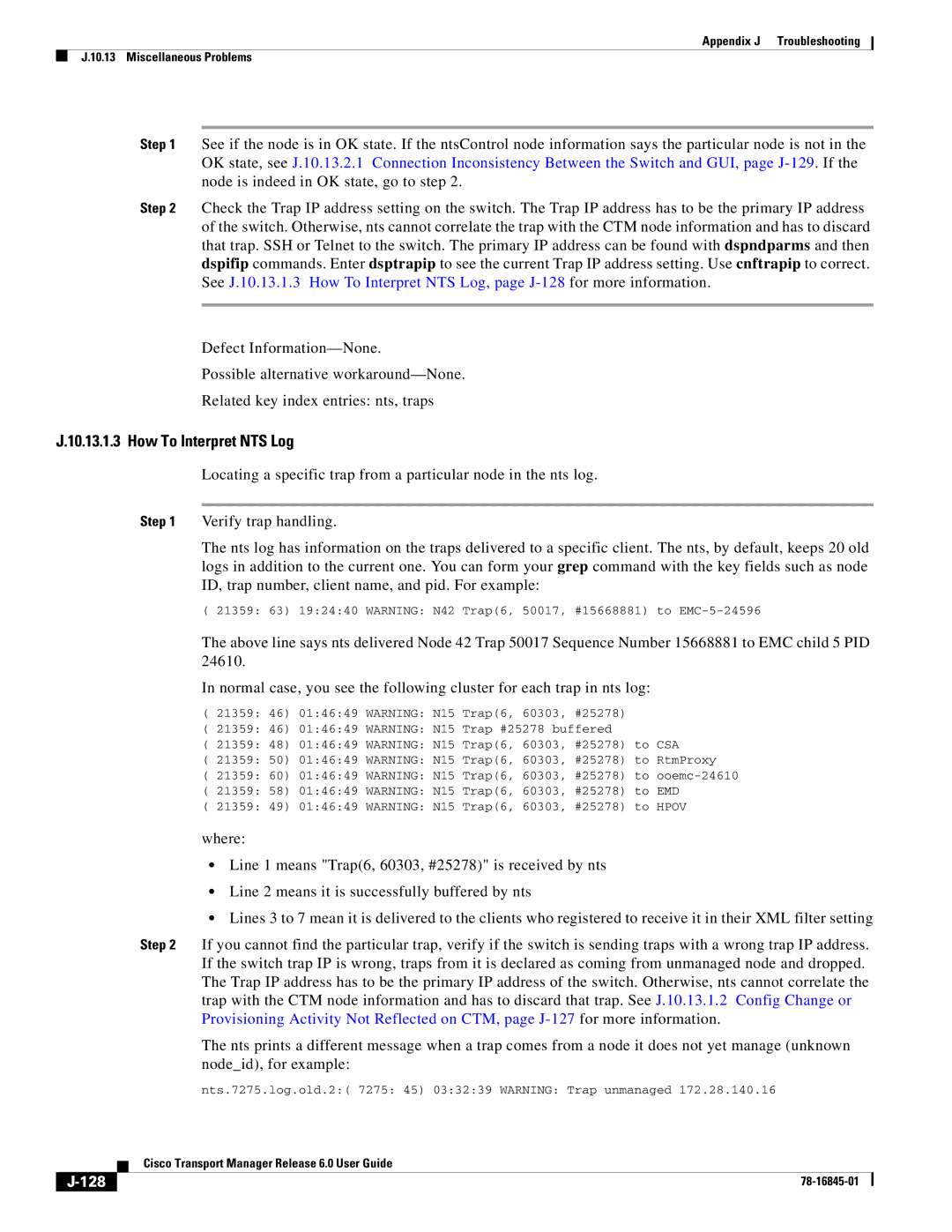
Appendix J Troubleshooting
J.10.13 Miscellaneous Problems
Step 1 See if the node is in OK state. If the ntsControl node information says the particular node is not in the OK state, see J.10.13.2.1 Connection Inconsistency Between the Switch and GUI, page
Step 2 Check the Trap IP address setting on the switch. The Trap IP address has to be the primary IP address of the switch. Otherwise, nts cannot correlate the trap with the CTM node information and has to discard that trap. SSH or Telnet to the switch. The primary IP address can be found with dspndparms and then dspifip commands. Enter dsptrapip to see the current Trap IP address setting. Use cnftrapip to correct. See J.10.13.1.3 How To Interpret NTS Log, page
Defect
Possible alternative
Related key index entries: nts, traps
J.10.13.1.3 How To Interpret NTS Log
Locating a specific trap from a particular node in the nts log.
Step 1 Verify trap handling.
The nts log has information on the traps delivered to a specific client. The nts, by default, keeps 20 old logs in addition to the current one. You can form your grep command with the key fields such as node ID, trap number, client name, and pid. For example:
( 21359: 63) 19:24:40 WARNING: N42 Trap(6, 50017, #15668881) to
The above line says nts delivered Node 42 Trap 50017 Sequence Number 15668881 to EMC child 5 PID 24610.
In normal case, you see the following cluster for each trap in nts log:
( 21359: 46) 01:46:49 WARNING: N15 Trap(6, 60303, #25278)
( 21359: 46) 01:46:49 WARNING: N15 Trap #25278 buffered
( 21359: 48) 01:46:49 WARNING: N15 Trap(6, 60303, #25278) to CSA
( 21359: 50) 01:46:49 WARNING: N15 Trap(6, 60303, #25278) to RtmProxy
( 21359: 60) 01:46:49 WARNING: N15 Trap(6, 60303, #25278) to
( 21359: 58) 01:46:49 WARNING: N15 Trap(6, 60303, #25278) to EMD
( 21359: 49) 01:46:49 WARNING: N15 Trap(6, 60303, #25278) to HPOV
where:
•Line 1 means "Trap(6, 60303, #25278)" is received by nts
•Line 2 means it is successfully buffered by nts
•Lines 3 to 7 mean it is delivered to the clients who registered to receive it in their XML filter setting
Step 2 If you cannot find the particular trap, verify if the switch is sending traps with a wrong trap IP address. If the switch trap IP is wrong, traps from it is declared as coming from unmanaged node and dropped. The Trap IP address has to be the primary IP address of the switch. Otherwise, nts cannot correlate the trap with the CTM node information and has to discard that trap. See J.10.13.1.2 Config Change or Provisioning Activity Not Reflected on CTM, page
The nts prints a different message when a trap comes from a node it does not yet manage (unknown node_id), for example:
nts.7275.log.old.2:( 7275: 45) 03:32:39 WARNING: Trap unmanaged 172.28.140.16
| Cisco Transport Manager Release 6.0 User Guide |
|
